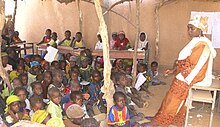You can help expand this article with text translated from the corresponding article in French. (December 2017) Click [show] for important translation instructions.
|
 | |
| Educational oversight | |
|---|---|
| Ministry of National Education | Rabiou Ousman |
| General details | |
| Primary languages | French |

Education in Niger, as in other nations in the Sahelian region of Africa, faces challenges due to poverty and poor access to schools. Although education is compulsory between the ages of seven and fifteen, with primary and secondary school leading into optional higher education, Niger has one of the lowest literacy rates in the world. With assistance from external organizations, Niger has been pursuing educational improvement, reforming how schools utilize languages of instruction, and exploring how the system can close gender gaps in retention and learning.[citation needed]
The Human Rights Measurement Initiative (HRMI)[1] finds that Niger is fulfilling only 59.2% of what it should be fulfilling for the right to education based on the country's level of income.[2] HRMI breaks down the right to education by looking at the rights to both primary education and secondary education. While taking into consideration Niger's income level, the nation is achieving 71.5% of what should be possible based on its resources (income) for primary education but only 46.8% for secondary education.[3]
- ^ "Human Rights Measurement Initiative – The first global initiative to track the human rights performance of countries". humanrightsmeasurement.org. Retrieved 2022-03-26.
- ^ "Niger - HRMI Rights Tracker". rightstracker.org. Retrieved 2022-03-26.
- ^ "Niger - HRMI Rights Tracker". rightstracker.org. Retrieved 2022-03-26.